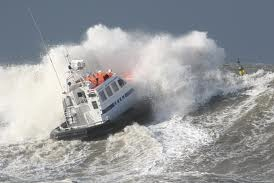A space-time formulation and a new discrete variational formulation for nonlinear potential flow water waves that includes wave-ship interactions
Organization:
Funded by: | STW - 3266 |
PhD: | Freekjan Brink |
Supervisor: | Jaap van der Vegt |
Collaboration: | Technical University Delft, University of Leeds |
Description:
The use of fast (10 to 60m) ships has become popular in maritime operations. They nowadays emerge in search and rescue operations, surveillance, Coast Guard activities, interceptor and security missions, anti drugs and piracy actions, in fast supply to offshore platforms, and for crew transport and wind farm maintenance. The main advantage is their speed, while the challenge is to maintain safe seakeeping at high speeds in mild to heavy seaway, while also keeping these ships affordable, reliable, fuel efficient and comfortable. This project will develop new simulation tools for the dynamics of fast ships and surrounding waves in breaking seas, and validates these simulations by comparing them to advanced and novel towing tank laboratory experiments.
Classical calculations of waves are based on (non)linear potential flow wave theory. Such simulations are quite good provided accurate numerical methods are used, but can never deal with wave breaking due to the potential flow Ansatz. In addition, potential flow wave codes in three dimensions need to become computationally more efficient. This requires further scientific development, especially when wave and ship dynamics are fully and nonlinearly coupled, as proposed. Another key issue is preservation of the variational formulation of wave dynamics, to ensure numerical stability, within our partially existing discontinuous Galerkin finite element methodology (DGFEM). This new method is by design constructed to include our (variational) potential flow limit with nonlinear ship dynamics. Hence, this new methodology for fast ships in breaking seas does require that the DGFEM for the combined ship and potential flow wave dynamics is fully developed as well. The wave breaking will be handled using single-phase mixture theory in a collaborative project in the University of Leeds. Essential is the anticipated validation of both (integrated) simulation tools against data from advanced and new towing tank experiments. This data will be provided by a collaborative project in Technical University Delft. The proposed simulation tools supporting new hull designs will form a sustained investment.
Publications:
Pictures:
| Fig 1: Example of a ship of the Dutch rescue organisation (KNRM) in action.) |

